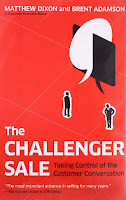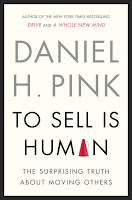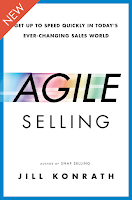As a sales process consultant, I'm often asked to recommend books to help clients navigate their way through one issue or another. Over time I've realized that I keep referring people to the same books over and over. I've come to think of them as the Essential Sales Bookshelf. If you're in sales and you don't own them, go shopping!

The Challenger Sale : Taking Control of the Customer Conversation by Matthew Dixon and Brent Adamson (2011, Hardcover) If you’re in sales at all, rep, manager, VP, or Director, this book is vital to selling in the internet age. Because we have access to so much information, most buyers have quite a few pre-conceived notions that will keep them making the same mistakes, and the same purchases, over and over again. This book revolutionized sales by demonstrating that the most successful reps challenge the thinking and habits of their prospects, making room for a new conversation.
The Challenger
Customer : Selling to the Hidden Influencer Who Can Multiply Your Results
by Matthew Dixon, Pat Spenner, Nick Toman and Brent Adamson (2015, Hardcover) Taking into account that almost all purchases
are made by teams (the team behind the Decision Maker) this book identifies who
those other players are, and demonstrates how many other decision makers they
influence. Instead of strictly selling to the “DM” The Challenger Customer
challenges us to sell to the people with the most influence as well.
 Drive : The
Surprising Truth about What Motivates Us by Daniel H. Pink (2009,
Hardcover) Recognizing the core
components of what motivates humans to act and feel in particular ways is key
in a successful sales process. By understanding the motivational factors in
play, a sales pro can much more effectively navigate some of the seemingly
unreasonable objections and requests we receive from so many sales prospects.
Drive : The
Surprising Truth about What Motivates Us by Daniel H. Pink (2009,
Hardcover) Recognizing the core
components of what motivates humans to act and feel in particular ways is key
in a successful sales process. By understanding the motivational factors in
play, a sales pro can much more effectively navigate some of the seemingly
unreasonable objections and requests we receive from so many sales prospects.To Sell Is Human : The Surprising Truth about Moving Others by Daniel H. Pink (2012, Hardcover) Mr. Pink takes us through the psychology of basic social behaviors, and demonstrates that many of our core interactions with others are fundamentally selling them on our idea, desire, or offering. Sales is primarily based in persuasion, and secondarily in filling a need or solving a problem. So, as it turns out, is most human interaction. Recognizing the similarities helps sales pros develop natural, agile relationships with their prospects.
Fanatical Prospecting : How to Open Doors, Engage Prospects, and Make
One Last Call by Jeb Blount (2015, Hardcover) As I tell my sales reps, “You’ll
never close what you didn’t open.” Fanatical Prospecting is a step by step
guide about opening a sales relationship with prospects, instead of just “networking.”
Activity is not a result in itself, and often too much time is spent collecting
business cards and phone numbers. What counts is making the contacts that are
the beginning of a sales relationship. With this book, it just became much easier.
The Art of Closing
the Sale : The Key to Making More Money Faster in the World of Professional
Selling by Brian Tracy (2007, Hardcover)
Of course with all that opening of sales conversations, you’ll want to
make sure you’re closing as many deals as possible. From Brian Tracy, we learn
that many of the old closing techniques no longer work at all because of the colossal
number of ads and transactions people perform every day. We’ve become immune.
What works now? A more natural,
transparent approach that challenges expectations.
SNAP Selling : Speed up Sales and Win More Business with Today's
Frazzled Customers by Jill Konrath (2010, Hardcover) Jill Konrath has been
helping sales professionals assess the sales climate for decades, and her work
resonates over time. In this book from
2010, she helps us identify the overwhelmed buyer. With so many options and so
much information available for each purchasing decision, sometimes what is
needed is to break the sale down into a few simple, but key, steps. A must-read
for highly competitive industries.
 Agile Selling : Get up to Speed Quickly in Today's Ever-Changing Sales
World by Jill Konrath (2014, Hardcover) Finally, a book about onboarding
sales pros in a way that they can start selling within the first few weeks!
Onboarding as a new sales rep in an unfamiliar industry often takes months to
over a year to become fully competent in your role. Agile Selling addresses the
issue head on, inviting sales reps to approach learning their new industry and
market differently, making consistent, useful progress from Day 1.
Agile Selling : Get up to Speed Quickly in Today's Ever-Changing Sales
World by Jill Konrath (2014, Hardcover) Finally, a book about onboarding
sales pros in a way that they can start selling within the first few weeks!
Onboarding as a new sales rep in an unfamiliar industry often takes months to
over a year to become fully competent in your role. Agile Selling addresses the
issue head on, inviting sales reps to approach learning their new industry and
market differently, making consistent, useful progress from Day 1. 









